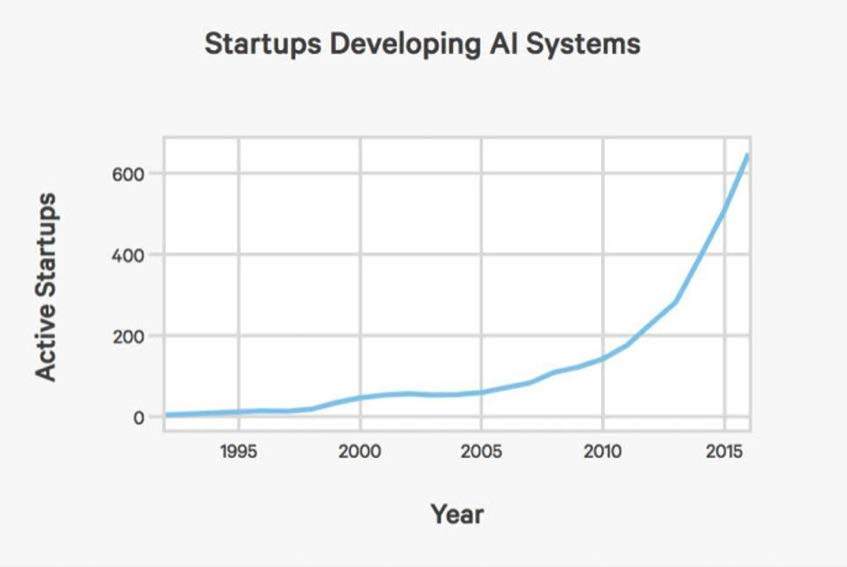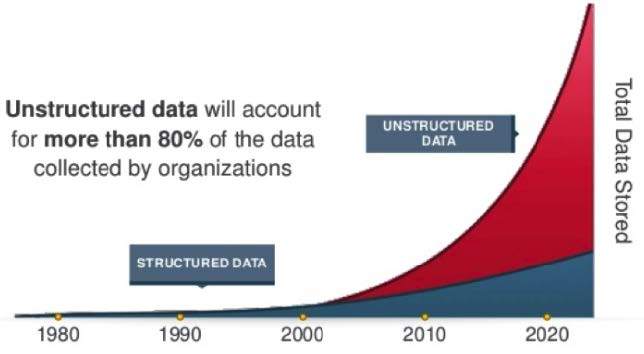In the fast-moving pace and pressing concerns of our daily work and responsibilities, it’s easy to lose track of the change that is constantly occurring in the IT landscape. I look back just a few years ago and am struck by how different so many of the issues, concerns and technologies are today. In the midst of this continually shifting IT landscape, we thought it would be good to pause as we begin a new year and look at some of the important trends we see in the year ahead.
Clearly one of the most striking trends in IT today is the inexorable growth of Artificial Intelligence (AI) and machine learning. I’m sure we’re all aware that AI is taking off and it appears as though we’re just at the knee of the curve of its growth and adoption.
In a recent Forbes article, Louis Columbus reports that since 2000 the number of active AI firms has increased by over 14 times, that VC funding has grown six-fold since then, and that it is projected that AI alone will account for a 38% growth in corporate profits by 2035. Those are pretty incredible numbers.

Given this inexorable shift toward AI and machine learning, the question IT professionals need to be asking today is, “How does my team plan for and architect an infrastructure that will support AI?” Among several others, we think your storage platform will be a huge consideration here. Because of the business imperatives that AI will support and enable, the underlying storage solution will have to, at a minimum, have features like high availability, reliability, high performance, ease of use and automation.
Just taking storage performance for example, it’s obvious that to ingest, to retrieve and to analyze massive amounts of data your storage platform will be crucial. It will have to be able to provide maximum I/O’s and very low latency. And in that, we think NVMe systems will be imperative. The good news is that there are options on the market today that can deliver here. We have several clients across the country, including one federal agency, that are using these NVMe high performance storage systems and they’ve had really impressive results with them.
Again, this is just one consideration among a host of others that will be important to think through and architect for as you lay a foundation that will support the demands of AI and machine learning.
HCI is another trend that is experiencing impressive growth and adoption. Gartner projects that HCI revenue will grow at a compounded annual rate of more than 60% in the next few years. Right now we’re working with several clients across the country looking to deploy HCI solutions. One of those clients is a Northwest university with an infrastructure that has aged and has become increasingly difficult to manage. They see HCI as a way to address that growing complexity in a straightforward way. Significantly they are looking for a system that won’t further tax their already overworked IT team.

The conversations we’ve had with this university and others - including a Boston-based software firm - have highlighted for me some of the key drivers for HCI and help explain it’s rapid growth.
The first, is that HCI can offer a shared resource pool and thus will make the university take advantage of the flexibility and lower TCO cloud-like infrastructure. The second, is simplified management. Being able to manage compute, network and storage from a single platform and single pain of glass will obviously represent a huge step forward. Finally, and the most important driver in our conversation yesterday, was the ability of HCI to deliver a highly available and highly redundant IT infrastructure. The university has two data centers so of course it’s important for them to take full advantage of that by deploying a solution that’s highly available.
So when you take all these different drivers together you can see why so many organizations are taking a long hard look at HCI and we believe that will only grow in 2018. Encouragingly, HCI solutions on the market today have really matured rapidly over the past
several years and now there are some compelling options worth taking a hard look at.
As we highlighted in our recent Advanced Malware Defense Workshop, it’s news to no-one in IT that malware attacks are growing precipitously and attackers are becoming increasingly sophisticated by leveraging multiple and simultaneous attacks including distributed denial of service or DDOS attacks coordinated with ransomware or malware attacks.
We also explained in the Workshop that a more effective way to deal with zero day attacks may be a default deny posture. With more than a third of attacks being a zero day event, we believe this is a critically important consideration. That said, there are obviously so many more facets of cyber security and it’s important to realize there is no silver bullet solution out there for anyone. What’s required, we believe, is a comprehensive, intelligent approach to securing data and data flow specific to your company. Once you determine what that strategy is going to be, it needs to become a part of your organizational culture supported by every department and at all levels.

While this may sound daunting, it is actually far simpler to do when leveraging preexisting cyber security frameworks. These frameworks not only help improve processes and help educate your teams, but they’ll also provide a filter by which you can judge different vendor technologies and solutions that can help you achieve your security goals.
Finally, we know there are many organizations that are struggling to meet deadlines for local, national or international cyber security standards like GDPR, NIST, HIPPA, and PCI. Sure, this can be a daunting challenge but the good news is that there is a way to approach these requirements using an umbrella structure that can help you address many different standards using a single methodology. This umbrella approach facilitates learning and implementation by providing templates and workshops and dedicated help so that you can focus on your job as an IT leader or team member.
Over the past several years, we’ve all seen incredible growth in unstructured data. And it’s clear that that trend will continue. As such, we believe it’s important to consider the challenges and some of the promising breakthroughs in Secondary Storage.

Many of our clients around the country are faced with issues around secondary storage and there are many reasons for this.
A primary challenge around secondary storage is that these environments are typically siloed ones. You have something for backup, something for test and dev and some other solution for file and object. A corollary problem here is that these siloed environments prove very difficult to scale. Finally, even though your secondary storage may not be core to your operations or production, taken as a whole, these silos add a lot of management overhead to an organization.
Another challenge today in secondary storage is that of this data is essentially dark to many organizations because it can’t be accessed or analyzed easily. The issue though, is that there is a growing imperative to be able to have real time access to that data for business analytics or AI applications.
Finally, legacy secondary storage solutions were obviously not built to integrate with the cloud and as such, the default for long term or archival storage has been tape. But I don’t think there are very many of us who would choose tape as our first choice, particularly, as the cloud becomes a more and more compelling option for our archiving, tiering and replication.
The good news, in light of all these challenges, is that there are some new and exciting technologies that have entered the market in the last several years that provide compelling secondary storage solutions. Solutions that can hyper scale, that can integrate natively with the cloud, that can provide instant restores and real-time access to data, that not very long ago, would have been dark. It’s because of these reasons and many others that we believe these new secondary storage solutions will become part of the IT Landscape more and more in 2018.
Obviously there are many others trends and new technologies we could have called out but I trust this is of some help to you and your team. As always if it would be helpful to have a conversation about one or more of these topics, we would welcome the conversation.
Contact us today for a low-key conversation about your current environment, pain points as well as long-term goals. Our national-caliber consultants look forward to speaking with you soon.
Schedule My Session